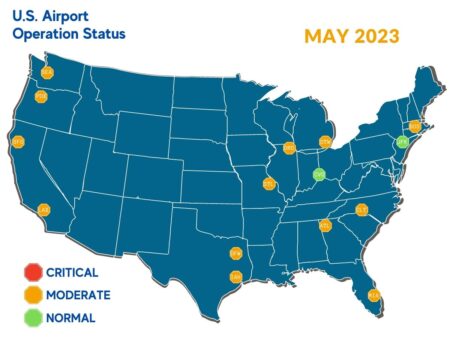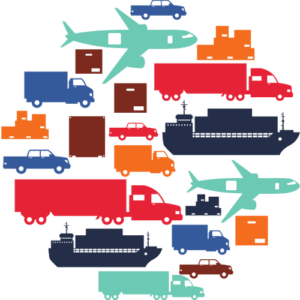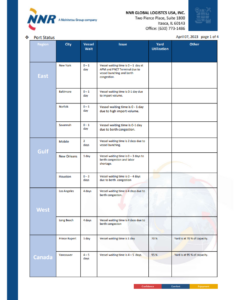
May 2023 – Market Update
By USA In Insight On 11th May 2023
Upcoming Holidays
USA - No delays for Memorial Day - Monday, May 29th
AIR
We forecast a relatively stable May. Most air carriers continue to have a few intermittent operational issues, including delays at specific intermediate airports due to capacity constraints.
Fuel surcharges (FSC) continue to fluctuate on a short-term basis, with recent long-term trend lines showing slow, modest FSC rate declines. 
The World Health Organization officially ended the global emergency status for Covid-19 on May 5th, 2023.
What does that mean for you?
- Relaxed Covid travel restrictions, with more countries opening up without any requirements. That, of course, includes China, which removed the Covid lockdown before its long Labor Day holiday that ended last week.
- More airlines are adding flights for passengers which adds belly cargo capacity. For example, Virgin is adding two extra flights to London and one to Manchester from JFK. British Airways is adding up to a total of seven flights daily. Qantas is adding capacity from Chicago to Sydney. Air Canada has new freighter service Miami to Toronto, Bogota, Lima, and Quito!
- More capacity can mean more competitive pricing is available on those trade lanes flying cargo-empty.
- Transit time on certain lanes is reduced due to more flight options and fewer delays.
Discuss with your NNR contact your shipment ‘need by’ date. Our team will help you find shipping options specific to your needs. If you have more flexibility, it could mean a more competitive rate too!
OCEAN
Many Business Cargo Owners (BCO) and Non-Vessel Operators (NVO) wrapped up their Trans-Pacific East Bound (TPEB) contracts negotiations by signing the new contracts after the carrier’s success of general rate increase (GRI) implementation on April 15.
This year, contract negotiations took longer than usual as spot rates were declining for months, making many BCOs and NVOs hold on to sign and seek lower rates for long-term agreements. That strategy did not work much as indications of rate increases are surging with carrier’s blank sailings and bringing space availability down by almost 30%. That being said, rates are still lower than levels reached during the last two and half years.
- Many carriers’ Q1 results show a drop in profits by up to 75% from last year! This reflects volumes drop across the globe and a slowdown in bookings due mainly to overstocking of goods at many warehouses and a decline in demand for goods by consumers. Many carriers are hoping for a rebound in demand during summer time for back-to-school and winter for the traditional holidays shopping season.
- On labor updates between International Longshore and Warehouse Union (ILWU) and Pacific Maritime Association (PMA), the latest news is in a positive direction after an agreement involving manning requirements for cargo handling equipment at conventional container terminals in Los Angeles and Long Beach. NNR is monitoring the negotiations between both parties and hopes that the ILWU and PMA can reach a fair and mutually beneficial agreement soon.
Please continue to book despite the space availability. Carriers are still voiding sailings which can disrupt normal schedules and vessel rotations.
TRANSPACIFIC - U.S. EAST COAST
The Panama Canal, one of the world's most important maritime trade routes, is experiencing another drought.
The canal handles approximately 6% of global maritime trade, connecting the Atlantic and Pacific Oceans. Any disruption in operations can have significant impacts.
In 2019, when the canal faced a severe drought, the shipping industry faced many delays as the canal's water levels were too low for larger vessels to pass through. The drought lasted several months, causing significant economic issues for the shipping industry and affecting global trade. At that time, the Panama Canal Authority (PCA) implemented measures to reduce the draft limit, which is the maximum depth of a ship that can pass through the canal. The draft limit was reduced from 50 to 44 feet. Many ships had to wait for days, even weeks, to pass through the canal, causing a backlog in shipping schedules and increasing the cost for shippers. The delays caused ripple effects on global supply chains, with goods being delayed or rerouted to alternative routes resulting in additional fees and inefficiencies.
The PCA recently announced draft reductions for vessels transiting the Neopanamax locks. Effective May 24, 2023, the maximum draft will be 44.5 feet Tropical Fresh Water (TFW), and effective May 30, 2023, the maximum will be 44.0 feet TFW.
It is important to follow the ongoing drought developments to prevent any delays or additional costs to your supply chain.
Don't hesitate to get in touch with NNR for a thorough review of your current ocean business. We can provide solutions and mitigate risk to your business.
U.S. PORT AND RAIL STATUS CHART
Click on the link below for more information on ocean!

Find NNR Offices Near You
Contact our team for more forwarding solutions.

